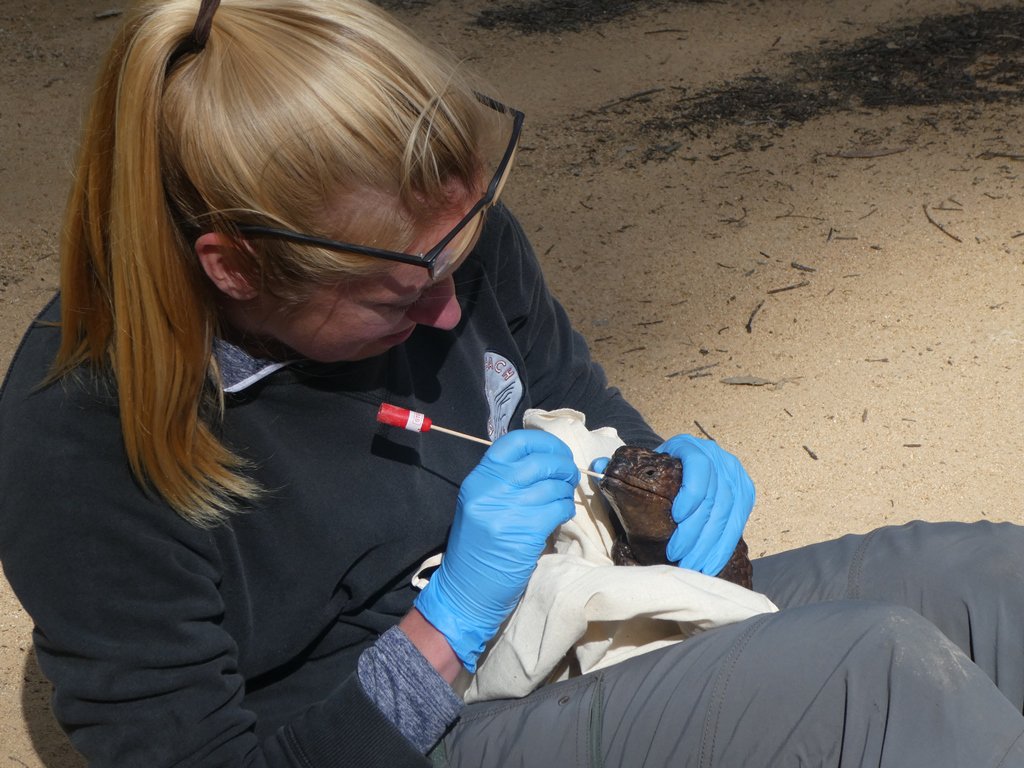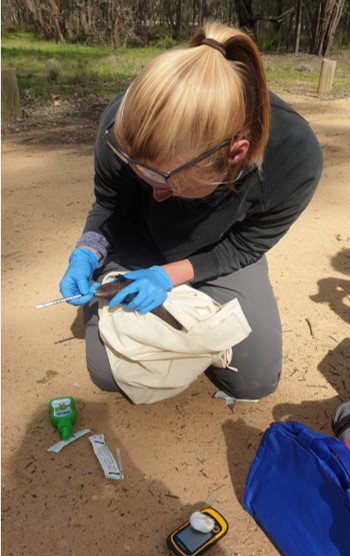Catching Lizards to stop Lizard catchers: New genetic tools to prevent shingleback poaching
In a world first, PhD candidate Amber Brown with supervising scientists have developed and validated a fit-for-purpose mitochondrial DNA kit to identify shingleback DNA – and created one of the only phylogeographic genetic databases to track the genetic lineage of confiscated shingleback lizards.
Many Australians view shinglebacks (Tiliqua rugosa) as ordinary visitors in their back gardens – commonplace lizards that they regularly encounter. In Australia, these animals have their own set of nick-names: “bobbies”, “sleepies”, “pinecone lizards” or “shinglebacks”. Shinglebacks, one of Australia's iconic blue-tongue skinks, are marketed as the "romantic lizard" or “Godzilla pets” – and overseas, these animals are highly valued as exotic pets.
Unfortunately, it is comparatively easy to poach a shingleback lizard. They are docile in nature, easy to catch by hand and are relatively easy to traffic as they are non-vocal. These factors, coupled with the low-risk of prosecution for these crimes, has resulted in hundreds of shinglebacks being trafficked from Australia each year. When shinglebacks are identified and confiscated in transit, we often cannot tell where in the wild they came from and biosecurity risks prevent them from being re-released into the environment. Therefore, the fate of most trafficked shinglebacks is a life in captivity or unfortunately euthanasia. This is particularly devastating, as shinglebacks are considered “monogamous” – finding the same mating partner year after year. So, deterring animals being removed from the wild in the first place is the best outcome for this species.
With this in mind, discussions between the Australian Centre for Wildlife Genomics (the only ISO/IEC 17025 accredited wildlife forensics facility in Australia) and State and Federal agencies responsible for investigating wildlife crime, took place. These agencies highlighted the need for forensics tools to assist with shingleback trafficking. From these discussions, we aimed to develop a cost and time effective genetic method to identify from where in the wild confiscated lizard originated.
Shingleback lizards are distributed from the east to west coast of Australia. Therefore, we used mitochondrial DNA sequencing to help us narrow down where poaching is occurring – vital intelligence needed to mitigate this trade. Additionally, we wanted to develop genetic tools to identify if shingleback DNA was present in suspected poaching events, but when the actual lizards are no longer present. These samples can include empty tanks or packaging from which indirect samples (swabs, faeces, sheds) can be retrieved. To do this, we developed protocols to reliably retrieve very small amounts, as well as highly degraded, shingleback DNA.

© Paul Thomas

© Paul Thomas
We needed to compile a shingleback genetic database that extended across the entire range of the species to capture as much of the genetic diversity in the species as possible. To do this, we conducted fieldwork across Australia to collect genetic samples from wild shingleback lizards. Despite the challenges of the 2019-2020 bushfires, followed by COVID-19 restrictions and border closures, we were still able to collect DNA samples from wild shingleback populations from New South Wales, South Australia and Western Australia. To fill in sampling gaps in areas that we could not access, we also used DNA samples archived in the Australian Museum, the Western Australian Museum, the Queensland Museum and Museums Victoria collections to compile our database. Furthermore, captive shinglebacks and those confiscated from the illegal wildlife trade, now held at Featherdale Wildlife Park and the Australian Reptile Park, were also sampled to help test, optimise and validate our protocols. The result was the development of a validated genetic toolkit that could be used to generate intelligence data on where shingleback poaching is being carried out, as well as provide robust DNA evidence in for any prosecutions related to shingleback trafficking. It is also of one of the few species-wide genetic databases in wildlife forensic science.

© Australian Museum
In response to trafficking pressures, shinglebacks, along with all other Tiliqua skinks – including the iconic Blue tongue lizard (Tiliqua scincoides) – were proposed by the Australian Government as warranting regulation under the Convention on International Trade in Endangered Species of Wild Flora and Fauna (CITES). As of June 2022, shinglebacks are listed as an Appendix III species, which is a major step towards their conservation. With these additional regulations, the creation of this validated forensic toolkit will aid law enforcement in prosecuting individuals who traffic these Australian icons.
Amber O. Brown, PhD candidate, Australian Centre for Wildlife Genomics, Australian Museum; and Fellow Centre for Forensic Science University of Technology Sydney.
Dr. Greta Frankham, Scientific Officer, Australian Centre for Wildlife Genomics, Australian Museum & Industry Fellow Centre for Forensic Science, University of Technology Sydney.
Dr. Maiken Ueland, ARC DECRA Fellow & Senior Lecturer, Centre for Forensic Science, University of Technology Sydney.
Dr. Barbara Stuart, Adjunct Associate Professor, Centre for Forensic Science, University of Technology Sydney.
More information:
Brown, A. O., Ueland, M., Stuart, B. H., & Frankham, G. J. (2022). A forensically validated genetic toolkit for the species and lineage identification of the highly trafficked shingleback lizard (Tiliqua rugosa). Forensic Science International: Genetics, 102784.
Acknowledgements
We would like to thank Andrew V. Brown, Dr. Mike Gardner, Dr. Gerrut Norval, Dr. Jessa Clayton, and Dr. Aaron Fenner, Alisha Deo, Samara Garrett-Rickman and Dr. Paul Thomas for field work and sample collection assistance. We would like to thank Australian Museum staff, Andrew King, Scott Ginn, and Dane Trembath for their assistance. We thank the staff at Featherdale Wildlife Park including Chad Staples and Christina Kingsford and the staff at the Australian Reptile Park, including Tim Faulkner, Hayley Shute and Sam Herrmann for their support and help in sample collection. This work was funded through by the Australian Museum, the RSPCA Alan White Scholarship for Animal Welfare Research, the Society of Wildlife Forensic Science Small Grants Fund, The Holsworth Wildlife Research Endowment & The Ecological Society of Australia, the Peter Rankin Trust Fund for Herpetology, the UTS International Research Scholarship and the UTS President's Scholarship.



